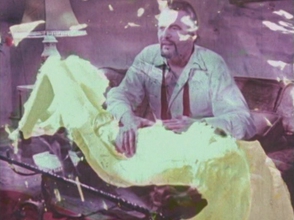On the 21/04/21, we continued to work with our Riso prints. I had brought a range of colour/size paper to trial in the Riso, mainly pastel colours as the inks are so bold, they possibly need a soft paper behind – was something me and Srin spoke of, as well as composition and imagery. I really enjoyed the images with the text in the mouth, from Andrea Dworkin’s Pornography essay so I refined the drawings so they would sit neatly in the mouth. I think it worked well in relation to the context of image and allowed the text to not consume the main image. I decided to try the original still from To Bite, I really enjoyed this in my first printing session, it was much more clear as Sweet Tooth B&W was confusing, couldn’t see what it was. See initial digital layers I used to create a draft.
Reflection 26/04/21: The still from To Bite is very successful, it’s clear its a mouth and a beard. The definition that is picked up from the pink ink almost exploits the beard, male dominance, in a grotesque way. Very defined and unsettling especially filling an A3 piece of paper.
I aim to try the first lay (text) above in yellow and remain the main image as pink. I think with an image like this and text, it doesn’t need much else, would become confusing to have more layers. We discussed sizes of paper – I think A3 works best as these works below are all A4 and I’m unsure if I like them, they feel quite compact. See images below, the colours paper works well, slightly changes the colour of the ink depending on the colour paper. The yellow text also seems to get lost on the coloured paper, is this something I want? Almost something which surprised me was the paper almost made the colours so unusual in person they made you feel dizzy and hurt your eyes.
Reflection 26/04/21: The black text on brown paper cancels this out, it almost acts as a focus point to the print and the paper helps soften the colours.
Reflection 26/04/21: I really wanted the yellow to work but it lost the ability to read the text. Yellow maybe more successful as a black background colour? Or not use it at all? I’m unsure.
Srin mentioned black would be more striking and works well with pink, I really inked the boldness of the blue previously so I decided to use black. In comparison like the image above, the back text prints stand out much more than the yellow in the pile. It invites the reader to then read the text rather than pass it by as words they can’t see. I stuck with this and began to print on brown paper which I did really enjoy with the first image and session, see below. Alongside this, me and Srin spoke about the orientation of the page – I hadn’t considered this much so I printed on the middle of page, portrait. They seem much more finalised being larger – the black text in the middle of the mouth also centralises the image, this was the composition to work with.
Reflection 22/04/21: Me and Srin discussed it maybe worth lining the box of the print with black to centralise/contain the image. It feels slightly unfinished due to the face coming off the page. We also discussed a black box above the face where the eyes would sit, making the print portrait – almost suggests these ideas of censorship of which I discussed in this practice and my dissertation – Ideas of wanting to look but you can’t, entice people in. Lack of identity. I aim to try this when I next print.
Reflection 23/04/21: Jane mentioned there was this Barbra Kruger type quality to these prints, the bold text with an impactful image almost forcing the viewers to read/listen.
Reflection 23/04/21: After my 1-1 with Jane today, we discussed how I would feel if I used text with my film. Jane mentioned it’s become successful in prints and may work to use text within my projections/films – m ay add that extra depth. Jane also asked how I feel about colours again after using print – I’m going to work and combining both black and white with some colour to draw the eye in – like these most recent prints.
After all this experimentation, I prefer the sand/brown paper with a portrait composition. The warm tone of the paper warms up the pink print – on white I felt it looked very bold and almost florescent which is too much in previously prints. The brown paper above that has a slight glow/shine to it, it it adds this glamorised feel to the print, this may be the paper I go with for the final print. Reflection 26/04/21: Glamorising the act, the text and the representation of women today, a new form of cellophane.














































